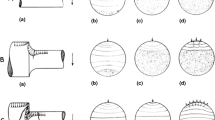Conclusion
A number of material failure modes were introduced in this article, including impact, spalling, wear, brinelling, thermal shock, and radiation damage. These mechanisms can affect metals, polymers, ceramics, and composites in various applications and in many different environments. Thus, it is important to take these failure modes into consideration during the design phases of a component or system in order to make appropriate materials selection decisions.
Part Three of this article will contain the final installment of failure modes. These will include uniform, galvanic, crevice, pitting, intergranular, and erosion corrosion; selective leaching/dealloying; hydrogen damage; stress-corrosion cracking; and corrosion fatigue.
Similar content being viewed by others
References
B.D. Craig: “Material Failure Modes, Part I: A Brief Tutorial on Fracture, Ductile Failure, Elastic Deformation, Creep, and Fatigue,” AMPTIAC Quarterly, 2005, 9(1), AMPTIAC, Rome, N.Y., pp. 9–16, http://amptiac.alionscience.com/pdf/2005MaterialEASE29.pdf.
“NASA Spur Gear Fatigue Data,” NASA Glenn Research Center, http://www.grc.nasa.gov/WWW/5900/5950/Fatigue-data.htm.
J.P. Shaffer, A. Saxena, S.D. Antolovich, T.H. Sanders, Jr., and S.B. Warner: The Science and Design of Engineering Materials, 2nd Edition, McGraw-Hill, Inc., 1999.
P. Niskanen, A. Manesh, and R. Morgan: “Reducing Wear With Superfinish Technology,” AMPTIAC Quarterly, 2003, 7(1), AMPTIAC, Rome, N.Y., pp. 3–9, http://amptiac.alionscience.com/pdf/AMPQ7_1ART01.pdf.
“Wear Failures,” Failure Analysis and Prevention, vol. 11, Metals Handbook, 9th ed., ASM International, 1986, pp. 145–62.
J.R. Davis, ed.: ASM Materials Engineering Dictionary, ASM International, 1992.
J.A. Collins and S.R. Daniewicz: “Failure Modes: Performance and Service Requirements for Metals,” M. Kutz, ed., Handbook of Materials Selection, John Wiley & Sons, Inc., 2002, pp. 705–73.
“Failures of Rolling-Element Bearings,” Failure Analysis and Prevention, vol. 11, Metals Handbook, 9th ed., ASM International, 1986, pp. 490–513.
“Projects Archive,” Air Force Research Laboratory, http://www.afrl.af.mil/images_projects.asp.
Author information
Authors and Affiliations
Additional information
This article is Part Two of a three-part series on material failure modes being published in the MaterialEASE section of AMPTIAC Quarterly. Part One introduced the concept of material failure modes and covered fracture, ductile failure, elastic deformation, creep, and fatigue. This article continues the discussion with brief descriptions of impact, spalling, wear, brinelling, thermal shock, and radiation damage. The next article will complete the series on material failure modes, and the three articles taken together will make a valuable desk reference for any professional making material selection and design decisions.
— Benjamin D. Craig, editor, AMPTIAC Quarterly
Editor’s Note: Part One of this series was printed in the October 2005 issue of JFAP (vol. 5, no. 5). Part Three will be printed in the April 2006 issue (vol. 6, no. 2).
Reprinted with permission from AMPTIAC Quarterly, 2005, 9(2), pp. 11–15; http://amptiac.alionscience.com/quarterly.
Rights and permissions
About this article
Cite this article
Craig, B.D. Material failure modes, part II: A brief tutorial on impact, spalling, wear, brinelling, thermal shock, and radiation damage. J Fail. Anal. and Preven. 5, 7–12 (2005). https://doi.org/10.1361/154770205X76240
Issue Date:
DOI: https://doi.org/10.1361/154770205X76240




